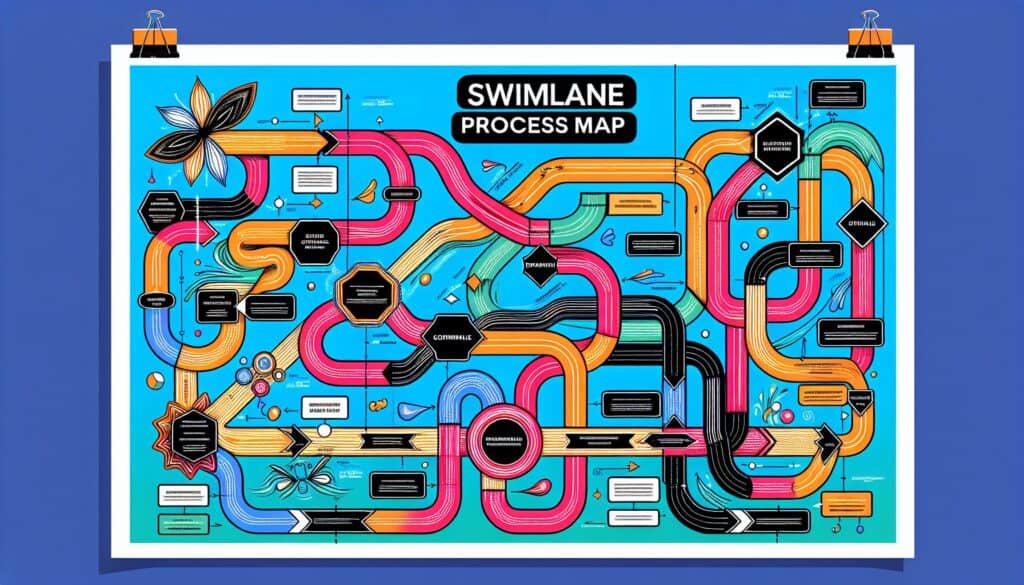To depict a process flow, clearly delineating the responsibilities and handoffs between different departments, roles, or systems.
- Methodologies: Customers & Marketing, Economics, Product Design
Swimlane Process Map

Swimlane Process Map
- Business Process Reengineering (BPR), Continuous Improvement, Cross-Functional Collaboration, Lean Manufacturing, Process Improvement, Process Mapping, Process Optimization, Quality Assurance, Quality Management
Objective:
How it’s used:
- A type of flowchart that organizes process steps into parallel "lanes," with each lane representing a specific actor or functional area. This visualizes who does what and where interactions occur.
Pros
- Clearly shows roles, responsibilities, and handoffs; Helps identify bottlenecks, redundancies, and communication gaps between groups; Improves clarity and understanding of complex processes involving multiple stakeholders.
Cons
- Can become cluttered if there are too many lanes or complex interactions; May require significant effort to create and maintain, especially for rapidly changing processes; Focus is primarily on "who" and "what," less on "how well."
Categories:
- Human Resources, Manufacturing, Problem Solving, Product Design, Project Management
Best for:
- Clearly illustrating how a process flows across different functional areas or roles, highlighting responsibilities and interactions.
Swimlane Process Maps find their application across various industries such as healthcare, manufacturing, software development, and finance, serving as an effective tool during the design and improvement of processes. Typically utilized during the analysis and optimization phases of projects, these maps can be initiated by project managers or process analysts, and involve participation from cross-functional teams, which may include stakeholders from operations, quality assurance, and customer service. They excel in clarifying the roles and responsibilities of different actors in a process, making them valuable in collaborative environments where multiple departments interact. For instance, in a healthcare setting, a swimlane map can delineate the flow of patient information from admission through treatment and discharge, making clear the responsibilities of nursing staff, physicians, and administrative personnel while also identifying communication gaps that may lead to delays in care. Similarly, in product development, these maps can outline the interaction between design, engineering, and marketing teams, exposing redundancies in handoffs and revealing opportunities for synergy. Their visual format makes it easier for various team members to engage in discussions about process improvements, thereby aligning goals and streamlining workflows across different organizational functions.
Key steps of this methodology
- Identify the key actors involved in the process.
- Map out the main process steps for each actor within their lane.
- Define the interactions and handoffs between the lanes.
- Clarify roles and responsibilities associated with each step.
- Analyze the workflow for potential bottlenecks and redundancies.
- Iterate on the map to improve clarity and accuracy.
- Validate the Swimlane map with stakeholders for feedback.
- Finalize the Swimlane diagram for implementation and communication.
Pro Tips
- Incorporate feedback loops in your swimlane maps to enhance adaptability and maintain alignment across all stakeholders during process evolution.
- Utilize color coding or symbols within the lanes to visually distinguish different types of activities, such as decision points or delays, enhancing quick comprehension of the workflow.
- Regularly update the swimlane map to reflect any changes in roles, responsibilities, or processes to ensure the document remains an accurate reference for all involved parties.
To read and compare several methodologies, we recommend the
> Extensive Methodologies Repository <
together with the 400+ other methodologies.
Your comments on this methodology or additional info are welcome on the comment section below ↓ , so as any engineering-related ideas or links.
Historical Context
1949
1950
1950
1960
1960
1960
1960
1940
1950
1950
1958
1960
1960
1960
1960
(if date is unknown or not relevant, e.g. "fluid mechanics", a rounded estimation of its notable emergence is provided)















Related Posts
Manufacturing Operations Management (MOM)
Manufacturing Execution System (MES)
Manufacturing Control Plan
Manual Testing
Manual Handling Assessment Charts (MAC)
ManTRA (Manual Tasks Risk Assessment Tool)